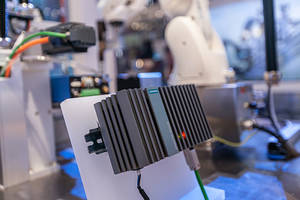New Simatic IPC227E Hardware Platform by Siemens Processes Large Amounts of Data
Press Release Summary:

Siemens’ new Simatic IPC227E hardware platform, suitable for industrial edge application uses, collects and processes data at the point of production before sending it to the company’s data storage. The device, which features closed metal housing, runs on a software platform that allows the user to adjust software applications as needed and update through a secure link. The software supports cloud transmission for MindSphere, and in the future will also support Message Queuing Telemetry Transport (MQTT).
Original Press Release:
Simatic IPC227E: New hardware platform for Edge applications
• Edge Devices to collect and process large data volumes directly at the machine• Secure, future-proof basis for the execution of Industrial Edge applications• Simple update procedure and software rollouts through secure link to central Edge Management System• Savings through edge computing in the Siemens Electronics Factory Amberg
At the SPS IPC Drives 2018 in Nuremberg, Siemens will be showcasing a newly developed hardware platform for edge applications as part of its Siemens Industrial Edge concept: The compact Simatic Edge Device works on the basis of the embedded industrial PC Simatic IPC227E, and features integrated connectivity to automation on the machine level. This allows manufacturing data to be captured and processed directly at the point of production.
If there is a change to the framework conditions underlying the industrial application, Industrial Edge offers facility to adjust software applications on the Edge Device, keeping them right up to date using functional, feedback-free updates.
The hardware comes with a closed all-metal housing, ensuring maximum industrial functionality for flexible, maintenance-free use under even the harshest of conditions. Rapid commissioning is guaranteed using pre-installed Edge software.
Siemens Industrial Edge
Siemens Industrial Edge affords users the opportunity to close the gap between classic local data processing and cloud-based data processing to suit individual requirements. Edge computing enables the local feedback-free processing of large data volumes practically in real time. Industrial Edge also enables users to cut the costs of data storage and transmission, as large volumes of data are processed in advance and exclusively relevant data is subsequently sent to the cloud or the company’s own internal IT infrastructure. Siemens Industrial Edge supports cloud transmission protocols for MindSphere, the open cloud-based IoT operating system from Siemens. In future, it will also support Message Queuing Telemetry Transport (MQTT), which will additionally guarantee the flexible exchange of data with other systems and clouds.
Savings through edge computing in the Siemens Electronics Factory Amberg
In the Siemens factory in Amberg, a printed circuit board cutting machine is used for the manufacture of Simatic products. During a milling operation, fine milling dust is produced which exerts an aggressive impact on the machine. This can cause the spindle bearing to jam, and potentially result in unscheduled machine downtime. To prevent this from happening, a number of the machine’s operating parameters are analyzed using artificial intelligence with a view to detecting any anomalies in spindle behavior which would indicate the possibility of an impending failure. This is done by transmitting data picked up by the sensors to the Edge device for analysis. A machine learning algorithm calculates the anomaly value in real time. A rise above a predetermined threshold value indicates that a machine failure is imminent. This Edge application enables cases of bearing erosion and machine downtime to be predicted between 12 and 36 hours in advance of an actual failure. In the event of anomalies, the machine spindle can be exchanged as part of the next scheduled service before a failure can cause costly unplanned downtime.
Background information:
When it comes to the analysis of production data on the basis of cloud-based solutions, manufacturers are faced with the dual challenge of managing their core task and also finding an efficient, economical solution for associated processes such as update handling and IT security. There are several ways to approach how data is collected and analyzed, and then used to improve processes.
Many are moving away from the classic use of local data processing, one of the drawbacks of which is a high level of outlay for software updating. They are choosing to take the digital route, relying on data processing and analysis based on central IT infrastructures (server farms) in the Internet in the form of cloud computing. This simplifies the task of updating and managing applications, as it allows updates to be installed on all servers via a central cloud management system. While cloud computing is becoming increasingly established, edge computing is evolving as a logical complement to it. These complementary systems enable production data to be either decentrally or centrally processed. Functionality, intelligence and data are no longer exclusively located in centralized server farms in the cloud, but optionally also on the field level, close to the data source – in the world of automation technology at the edge of the production network. The solution devised by Siemens – Siemens Industrial Edge – is based on proven hardware and software, and on mechanisms used in cloud technology, and integrates the benefits of local and cloud-based data processing.
This press release and a press picture are available at
www.siemens.com/press/PR2018110016DFEN
More information is available at www.siemens.com/industrial-edge
More information on Siemens at the SPS IPC Drives 2018 is available at
www.siemens.com/sps-ipc-drives and www.siemens.com/press/sps2018
Contact for journalists
Andreas Friedrich
Phone: +49 1522-2103967; E-mail: friedrich@siemens.com
Follow us on social media
Twitter: www.twitter.com/MediaServiceInd and www.twitter.com/siemens_press
Blog: https://blogs.siemens.com/mediaservice-industries-en
Siemens AG (Berlin and Munich) is a global technology powerhouse that has stood for engineering excellence, innovation, quality, reliability and internationality for more than 170 years. The company is active around the globe, focusing on the areas of electrification, automation and digitalization. One of the largest producers of energy-efficient, resource-saving technologies, Siemens is a leading supplier of efficient power generation and power transmission solutions and a pioneer in infrastructure solutions as well as automation, drive and software solutions for industry. With its publicly listed subsidiary Siemens Healthineers AG, the company is also a leading provider of medical imaging equipment – such as computed tomography and magnetic resonance imaging systems – and a leader in laboratory diagnostics as well as clinical IT. In fiscal 2018, which ended on September 30, 2018, Siemens generated revenue of €83.0 billion and net income of €6.1 billion. At the end of September 2018, the company had around 379,000 employees worldwide. Further information is available on the Internet at www.siemens.com.
Siemens AG
Communications
Head: Clarissa Haller
Werner-von-Siemens-Straße 1
80333 Munich
Germany




